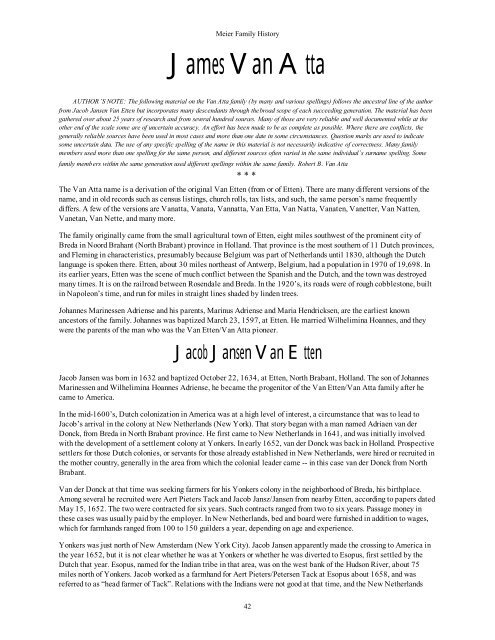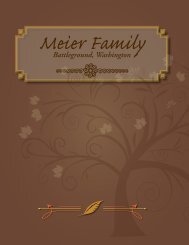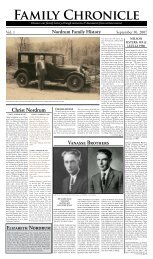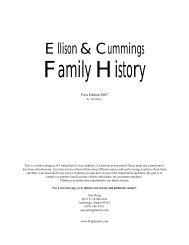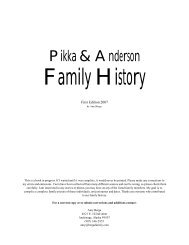Meier & Matson Family History
Meier & Matson Family History
Meier & Matson Family History
You also want an ePaper? Increase the reach of your titles
YUMPU automatically turns print PDFs into web optimized ePapers that Google loves.
<strong>Meier</strong> <strong>Family</strong> <strong>History</strong><br />
James Van Atta<br />
AUTHOR’S NOTE: The following material on the Van Atta family (by many and various spellings) follows the ancestral line of the author<br />
from Jacob Jansen Van Etten but incorporates many descendants through the broad scope of each succeeding generation. The material has been<br />
gathered over about 25 years of research and from several hundred sources. Many of those are very reliable and well documented while at the<br />
other end of the scale some are of uncertain accuracy. An effort has been made to be as complete as possible. Where there are conflicts, the<br />
generally reliable sources have been used in most cases and more than one date in some circumstances. Question marks are used to indicate<br />
some uncertain data. The use of any specific spelling of the name in this material is not necessarily indicative of correctness. Many family<br />
members used more than one spelling for the same person, and different sources often varied in the same individual’s surname spelling. Some<br />
family members within the same generation used different spellings within the same family. Robert B. Van Atta<br />
* * *<br />
The Van Atta name is a derivation of the original Van Etten (from or of Etten). There are many different versions of the<br />
name, and in old records such as census listings, church rolls, tax lists, and such, the same person’s name frequently<br />
differs. A few of the versions are Vanatta, Vanata, Vannatta, Van Etta, Van Natta, Vanaten, Vanetter, Van Natten,<br />
Vanetan, Van Nette, and many more.<br />
The family originally came from the small agricultural town of Etten, eight miles southwest of the prominent city of<br />
Breda in Noord Brahant (North Brabant) province in Holland. That province is the most southern of 11 Dutch provinces,<br />
and Fleming in characteristics, presumably because Belgium was part of Netherlands until 1830, although the Dutch<br />
language is spoken there. Etten, about 30 miles northeast of Antwerp, Belgium, had a population in 1970 of 19,698. In<br />
its earlier years, Etten was the scene of much conflict between the Spanish and the Dutch, and the town was destroyed<br />
many times. It is on the railroad between Rosendale and Breda. In the 1920’s, its roads were of rough cobblestone, built<br />
in Napoleon’s time, and run for miles in straight lines shaded by linden trees.<br />
Johannes Marinessen Adriense and his parents, Marinus Adriense and Maria Hendricksen, are the earliest known<br />
ancestors of the family. Johannes was baptized March 23, 1597, at Etten. He married Wilhelimina Hoannes, and they<br />
were the parents of the man who was the Van Etten/Van Atta pioneer.<br />
Jacob Jansen Van Etten<br />
Jacob Jansen was born in 1632 and baptized October 22, 1634, at Etten, North Brabant, Holland. The son of Johannes<br />
Marinessen and Wilhelimina Hoannes Adriense, he became the progenitor of the Van Etten/Van Atta family after he<br />
came to America.<br />
In the mid-1600’s, Dutch colonization in America was at a high level of interest, a circumstance that was to lead to<br />
Jacob’s arrival in the colony at New Netherlands (New York). That story began with a man named Adriaen van der<br />
Donck, from Breda in North Brabant province. He first came to New Netherlands in 1641, and was initially involved<br />
with the development of a settlement colony at Yonkers. In early 1652, van der Donck was back in Holland. Prospective<br />
settlers for those Dutch colonies, or servants for those already established in New Netherlands, were hired or recruited in<br />
the mother country, generally in the area from which the colonial leader came -- in this case van der Donck from North<br />
Brabant.<br />
Van der Donck at that time was seeking farmers for his Yonkers colony in the neighborhood of Breda, his birthplace.<br />
Among several he recruited were Aert Pieters Tack and Jacob Jansz/Jansen from nearby Etten, according to papers dated<br />
May 15, 1652. The two were contracted for six years. Such contracts ranged from two to six years. Passage money in<br />
these cases was usually paid by the employer. In New Netherlands, bed and board were furnished in addition to wages,<br />
which for farmhands ranged from 100 to 150 guilders a year, depending on age and experience.<br />
Yonkers was just north of New Amsterdam (New York City). Jacob Jansen apparently made the crossing to America in<br />
the year 1652, but it is not clear whether he was at Yonkers or whether he was diverted to Esopus, first settled by the<br />
Dutch that year. Esopus, named for the Indian tribe in that area, was on the west bank of the Hudson River, about 75<br />
miles north of Yonkers. Jacob worked as a farmhand for Aert Pieters/Petersen Tack at Esopus about 1658, and was<br />
referred to as “head farmer of Tack”. Relations with the Indians were not good at that time, and the New Netherlands<br />
42


